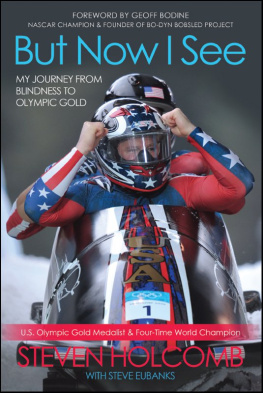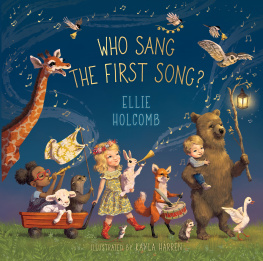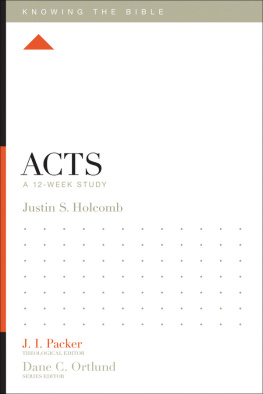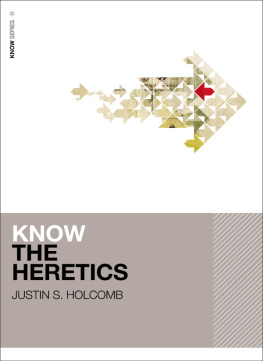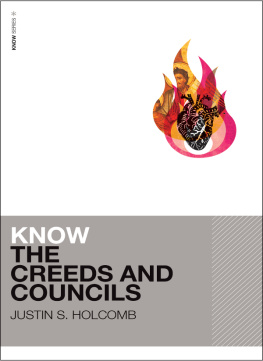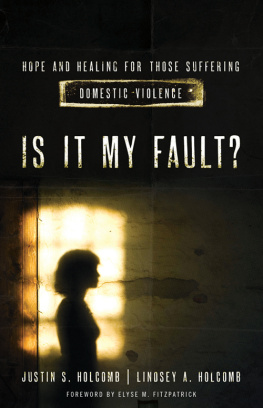
Copyright 2012, 2013 by Steven Holcomb
Paperback edition 2013
All rights reserved. No part of this book may be used or reproduced in any manner whatsoever without written permission except in the case of brief quotations embodied in critical articles or reviews.

BenBella Books, Inc.
10300 N. Central Expressway, Suite 400
Dallas, TX 75231
www.benbellabooks.com
Send feedback to
Printed in the United States of America
Second e-book edition: December 2013
ISBN 978-1-939529-85-5
Library of Congress Cataloging-in-Publication Data has cataloged the hardcover edition as follows:
Holcomb, Steven, 1980
But now I see : my journey from blindness to Olympic gold / by Steven Holcomb with Steve Eubanks.
pages cm
ISBN 978-1-937856-00-7 (hardcover) ISBN 978-1-937856-01-4 (e-book) 1. Holcomb, Steven, 1980- 2. Olympic athletes--United StatesBiography. 3. Blind athletesUnited StatesBiography. 4. BobsleddersUnited StatesBiography. I. Eubanks, Steve, 1962- II. Title.
GV697.H648A3 2012
796.092--dc23
[B]
2012047564
eISBN 978-1-9378-5601-4
Edited by Debbie Harmsen
Copyediting by Lisa Miller and Stacia Seaman
Proofreading by Chris Gage, James Fraleigh, and Thuy Vo
Cover design by Sarah Dombrowsky
Cover photo courtesy of Getty Images
Text design and composition by Neuwirth & Associates, Inc.
Printed by Bang Printing
Distributed by Perseus Distribution
(www.perseusdistribution.com)
To place orders through Perseus Distribution:
Tel: (800) 343-4499
Fax: (800) 351-5073
E-mail:
Significant discounts for bulk sales are available. Please contact Glenn Yeffeth at or (214) 750-3628.
Praise for But Now I See
Steven is a class act, and his story is one of perseverance. I am lucky to have heard it from Steven himself, just as you will in these pages. The Olympic Movement is a movement about friendship, excellence, and respect, and you will see those values very clearly in Stevens story.
SCOTT BLACKMUN, CEO, U.S. Olympic Committee
Steven Holcombs vision of a goal was not only seen with the eyes, but also with his heart! As you will read in But Now I See, true champions always find a way to win.
RICHARD H. WRIGHT, President/CEO, AdvoCare
To my mom and dad, for working so hard to give me every
opportunity possible and always believing in me
E ver since I was a boy in Chemung, New York, I have loved the thrill of racing. My family owned the town racetrack, and I was on it by about the same time I learned to tie my shoes. Fast cars, from hot rods to stock cars, just get me going. I love to be behind the wheel, and I also love watching racing. Im a huge fan.
In 1992 I watched a different kind of race, bobsledding in the Winter Olympics. I was enthralledand then appalled when I learned that no bobsleds were Made in the USA. We had to get ours from Europe and they were inferior to the sleds used by the other teams. I was outraged when I saw that the sleds were affecting our performance. How could Team USA not have equipment made in America?
After discussions with the USA Bobsled and Skeleton Federation and riding in a bobsled myself, I founded Bo-Dyn and worked with Bob Cuneo, the owner of Chassis Dynamics, to make a top-notch sled for our team. We didnt know what we were doing and were pressed for time. But we worked long and hard. We learned how bobsleds work, what makes them go fast, what feels right to the athletes. We built a sled that wasnt like anyone elses. And at the 2010 Olympics in Vancouver, Steven Holcomb drove The Night Train, built by our Bo-Dyn team, to gold medal victory.
Standing near the finish line as Steven and his team completed their Olympic journey of being 2010 Olympic four-man bobsled gold medal champions, and being the founder of the Bo-Dyn Bobsled Project, I understood how blessed I am to be an American and to have met the man Steven Holcomb. Steven put his country first in his life and first on the Olympic podium. Stevens courage and determination, which has guided him through his personal life and athletic life, demonstrates that he has the heart of a champion.
Reading this account about the segment of Stevens life that took him to becoming an Olympic bobsled gold medal winner has inspired me to appreciate his dedication to the sport, and I hope it will inspire you to reach out and support the Olympic Movement that men and women around the world are a part of.
Geoff Bodine
NASCAR Champion and Founder of
Bo-Dyn Bobsled Project
S tanding on the ice of the bobsled sliding track before the most important run of my life, I welcome fear like an old friend, and I know my three teammates feel the same way. We are at the 2010 Vancouver Olympic Games, and it is intense. All four of us shake our hands in the air as if weve touched a hot plate. One of my teammates rolls his head from side to side like a fighter before the start of a round, and we bounce on our toes to burn off nervous energy. This lasts only a couple of seconds, but it feels longer. Time passes slowly and quietly once I burrow deep into the mental rabbit hole that athletes call the zone. There are hundreds of screaming fans nearby, thousands in the stands, and more along the length of the sliding track, but the place might as well be empty. The cheers are like white noise. Every muscle is taut, every nerve is on edge. This is it.
We press the heels of our spiked shoes on the two-inch wooden block that passes as a starting line, and I crouch into a standing sprinters stance, loading all my energy into my glutes and quads. There is a verbal cadence, like a countdown, that establishing of a rhythm so we can explode in sync toward the sled. I finally take a few deep breaths as the cadence begins.
My teammates and I havent been silent, but we dont need to share our feelings either. We all know the stakes. Six seconds from now we will be loaded in the sled that I will pilot down one of the most dangerous tracks in Olympic history.
I drive The Night Train, an intimidating, flat black, four-man bobsled loosely named after a Harley-Davidson motorcycle that screams badass. It is already the most famous bobsled in the world, one that has sparked all kinds of crazy rumors about secret metal compounds and paints developed by NASA. We dont discourage such talk; in fact, we do what we can to foster it. Theres nothing wrong with setting up rent-free residency in your opponents heads, which is what weve done by staying quiet and letting the rumors fly. Now, with the words USA-1 painted on its nose, The Night Train looks fast even when its sitting still.
Every run begins from a dead stop. Our only propulsion comes from gravity and the initial force the four of us exert through pushing, which will start in less than a second. Weve made only about forty runs on this track, not a big number for an Olympic venue, but the Canadians decided early on to limit accessa smart move from a competitive standpoint, but one that has earned them a lot of criticism as the Vancouver Olympic Games have progressed. Bobsledding, luge, and skeleton use the same track. Those are, perhaps, the only Olympic sports where the host nation has a decided home-field advantage. The Canadian hockey team has the roaring support of the fans, but the dimensions of the rink arent changed to suit the team. The nets are the same size and the blue lines are in the same place as in every other hockey rink. The same is true in figure skating, half-pipe snowboarding, swimming, tennis, and basketball: the home team might have the crowd on its side, but the playing field isnt customized to benefit one team over another.

